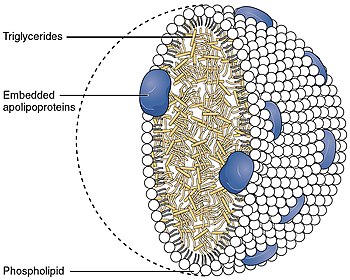Apolipoprotein
| Apolipoprotein | |||||||||
|---|---|---|---|---|---|---|---|---|---|
| OPM superfamily | 172 | ||||||||
| OPM protein | 3r2p | ||||||||
| |||||||||
Apolipoproteins are
The lipid components of lipoproteins are insoluble in water. However, because of their detergent-like (
In addition to stabilizing lipoprotein structure and solubilizing the lipid component, apolipoproteins interact with lipoprotein receptors and lipid transport proteins, thereby participating in lipoprotein uptake and clearance. They also serve as enzyme cofactors for specific enzymes involved in the metabolism of lipoproteins.[1]
Apolipoproteins are also exploited by hepatitis C virus (HCV) to enable virus entry, assembly, and transmission. They play a role in viral pathogenesis and viral evasion from neutralizing antibodies.[2]
Functions
In
Different lipoproteins contain different classes of apolipoproteins, which influence their function.
Apolipoprotein B plays a particularly important role in lipoprotein transport being the primary organizing protein of many lipoproteins.[1]
Apolipoprotein C-III (apoC3) plays an important role in lipid metabolism specific in regulating the metabolism of triglyceride-rich lipoproteins (TRLs).[6]
Apolipoprotein D (apoD) is a soluble carrier protein of lipophilic molecules in neurons and glial cells within the central and peripheral nervous system and apoD can also modulate the stability and oxidation status of these molecules.[7]
Apolipoprotein F (apoF) is one of the minor apolipoprotein in blood plasma and it is a lipid transfer inhibit protein to inhibit cholesteryl ester transfer protein-mediated transfers of cholesteryl esters and triglycerides.[10][11]
Apolipoprotein M (apoM) participates in the lipid metabolism and exhibit anti‑atherosclerotic functions and it is presented in high-density lipoprotein (HDL), low-density lipoprotein (LDL) and very low-density lipoprotein (VLDL).[12]
Classes
There are multiple classes of apolipoproteins and several sub-classes:
- Apolipoprotein A (
- Apolipoprotein B (Apo-B48 and Apo B-100)[b]
- ApoC-IV)[a]
- Apolipoprotein D
- Apolipoprotein E
- Apolipoprotein F
- Apolipoprotein H – a misnomer[13]
- Apolipoprotein L
- Apolipoprotein M
- Apolipoprotein(a)
Exchangeable apolipoproteins (apoA, apoC, and apoE) have the same genomic structure and are members of a multi-gene family that probably evolved from a common ancestral gene. Apo-AI and ApoA4 are part of the APOA1/C3/A4/A5 gene cluster on chromosome 11.[14]
Hundreds of genetic polymorphisms of the apolipoproteins have been described, and many of them alter their structure and function.
Evolution
The cluster of exchangeable apoliproteins is well conserved in
Beyond vertebrates, proteins similar to the exchangeable ApoA/C/E and the nonexchangable Apo-B are found in a wide range of animals and
Synthesis and regulation
Apolipoprotein synthesis in the intestine is regulated principally by the fat content of the diet.
Apolipoprotein synthesis in the liver is controlled by a host of factors, including dietary composition,
Apolipoprotein synthesis such as ApoA4 in hypothalamus involves in the integration of signals for regulation of food intake[5] which is regulated by vagal nerve and cholecystokinin.[17]
Disease
Apolipoprotein has been suggested to be implicated in several types of diseases and dysfunction.
ApoC1 level increases in neuropathic pain and fibromyalgia patients which suggest it plays an important role in occurrence of these conditions.[18]
ApoC3 is a risk factor of cardiovascular disease. Accumulation of plasma TRLs caused by elevated apoC-III leading to hypertriglyceridaemia.[19]
ApoD level increases in nervous system with a large number of neurologic disorders inclusive of Alzheimer's disease, schizophrenia, and stroke.[7]
ApoE has been implicated in dementia and Alzheimer's disease.[20]
Apo(a) is a component of lipoprotein(a) (Lp(a)) and elevated plasma Lp(a) level is a heritable, independent, and possibly causal risk factor for Atherosclerotic Cardiovascular Disease (ASCVD).[21] The cholesterol-rich apoB-containing lipoproteins also participate in the pathogenesis of ASCVD.
References
- ^ a b Either roman numerals or arabic numbers may be used for gene family members. For example, apoA5 is also known as apo A-V.
- ^ Isoforms from the same gene by alternative splicing.
- ^ S2CID 6925754.
- PMID 29977246.
- PMID 24780726.
- PMID 2159462.
- ^ PMID 11294757.
- PMID 18399797.
- ^ PMID 24612673.
- PMID 15234552.
- PMID 2063194.
- PMID 9880564.
- PMID 6816269.
- PMID 25901639.
- S2CID 43329586.
- S2CID 24857340.
- PMID 9238027.
- ^ S2CID 3758905.
- PMID 23027805.
- PMID 31686904.
- S2CID 34553066.
- PMID 28298292.
- S2CID 204886420.

